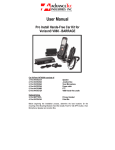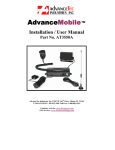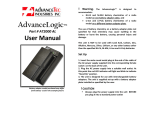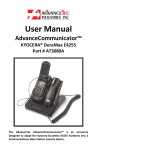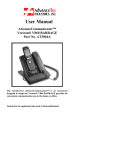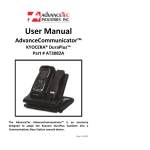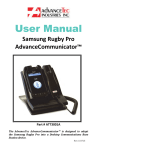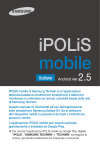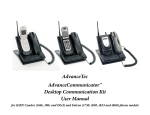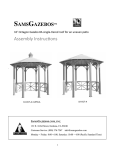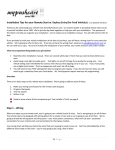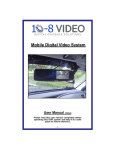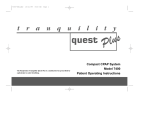Download User Manual - AdvanceTec™ Industries Inc.
Transcript
rd 1150 NW 163 Drive, Miami, FL 33169 User Manual Pro Install Hands-Free Car Kit for Motorola® i465 Car Kit Part # AT6850A consists of: 1. Part # AT8231A 2. Part # AT8241A (Grey) 2. Part # AT8230A 3. Part # AT8232A 4. Part # AT9299B 5. Part # AT6310A Speaker Junction Box Visor Microphone. Power cable PTT i465 Hands-free cradle Optional Extras 1. Part #AT7107A 2. Part # AT8410A 3. Part # AT8407A Privacy Handset Palm Mic. Mag. Mount Antenna 2 Before beginning the installation process, determine the best locations for the mounting of the Mounting Bracket, Handset Cradle, Push To Talk (PTT) button, Visor Microphone, Speaker and Junction Box. Consider the following guideline when planning the installation: * DO use all mounting hardware provided. * DO ensure that cables are not placed under stress. * DO follow proper + and - connections. * DO crimp connectors securely. * DO NOT attach components to any part of the vehicle that is not rigid or is subject to excessive vibration. * DO NOT install components in areas where rain or snow can easily get into them, such as next to a vehicle window, which may be left open. * DO NOT dress cables over sharp edges that could cause wear or tearing of cable insulation. * DO NOT install components in locations where they might interfere with the vehicle operator or operating controls. * DO NOT install the Hands-free Cradle where it will be difficult for the operator to reach. ! WARNING VEHICLES EQUIPPED WITH AIR BAGS An air bag inflates with great force. DO NOT place objects, including communications equipment, in the area over the air bag or in the air bag deployment area. If the communication equipment is improperly installed and the air bag inflates, this could cause serious injury. It is recommended that the installation of the vehicle communication equipment be performed by a professional installer/technician trained in the requirements for such installations. An air bag's size, shape and deployment area can vary by vehicle make, model, and front compartment configuration (for example, bench seat vs. bucket seats). Contact the vehicle manufacturer's corporate headquarters, if necessary, for specific air bag information for the vehicle make, model, and front compartment configuration involved in your communication equipment installation. Speaker Installation Detail Location 1. Mount the Speaker beneath the dashboard on the passenger's side of the vehicle, out of the way of the passenger, or some other convenient location. 2. Do not mount the Speaker on the dashboard or the rear window shelf. 3. The Speaker should be located more than four feet from the Car Kit Cradle. 3 Speaker Installation Procedure 1. The Speaker includes a mounting bracket, permitting it to be mounted in a variety of ways. Loosen the thumbscrews on the side of the speaker and using the mounting bracket as a template, drill the necessary mounting holes and secure the bracket with the self-tapping screws provide 2. Position the Speaker on the mounting bracket and secure it by tightening the thumbscrews. The mounting bracket is used to permanently mount the Speaker in place while permitting it to be tilted to a desired angle. Diagram 1 Junction Box Installation 1. Mount the Junction Box beneath the dashboard on the passenger's side of the vehicle or on the center side post between the front seats. It must be protected from dirt and moisture and must be afforded adequate space for cooling. There must be sufficient space to allow for connection of all cabling. Diagram 2 2. Connect the Cradle Control Cable, the Speaker, Microphone, Power cable and the PTT connectors to their respective corresponding connectors in the Junction Box, as shown in Diagram 3 below. Diagram 3 4 3. Route the cables out of the way to avoid physical or visual obstruction. Allow sufficient slack in the cable to the PTT so that it does not interfere with the movement of the gear lever. Caution! The Hands-free unit should be used with a negative ground system only. Power Cable Installation 1. Route the black lead of the main power cable to convenient chassis ground and the red lead to the positive supply voltage connection points. If it is necessary to penetrate the firewall, use an existing opening. 2. If necessary, drill a new hole approximately 9/16” or 3.5cm in diameter. Make sure that there is enough clearance on the opposite side. Insert a grommet into the hole to prevent damage to the power cable. 3. Cut the black lead to the desired length. 4. If the connection is being made under the dash or in the vehicle cabin, connect the black lead directly to the chassis of the vehicle. Note! Do not connect the black lead to the negative (-) battery terminal. The car could be damaged if there were a malfunction in the vehicle’s electrical system. 5. Cut the red lead to the desired length. This lead will be connected such that it has positive supply voltage at all times, even when the vehicle is turned off. 6. If the connection is being made under the dash or in the vehicle cabin, connect the red lead to a positive supply voltage point. 7. If the connection is being made in the engine compartment or directly to the battery, connect the in-line fuse holder between the red lead of the power cable and the desired positive voltage connection point. 8. Route and connect the green lead to a convenient ignition switch supply point in the vehicle. Diagram 4 Stereo Mute If the vehicle’s stereo system supports an external muting feature, route and connects the orange wire to the car stereo system. Otherwise, the orange wire may be left unconnected and cut off or tied out of the way. 5 NOTE! The Car Kit supports an “Entertainment Mute” function when connected to a car stereo system that provides for external muting. This function is compatible with systems that mute the audio output when the control line is connected to ground Mounting of the PTT – (To the gear lever or flat surface) 1. To attach the PTT to the gear lever, strap the PTT around the gear lever (see diagram 4 using the Velcro strip attached, with the cord facing down.) 2. To attach the PTT to a flat surface, remove the 2 screws from the bottom of the PTT, which holds the Velcro strip in place. Remove the strips and replace the small plastic part that held the strips in place with the larger flat plastic part supplied with the PTT. Screw the new plastic part in place. Diagram 5 3. Plug the connector end of the PTT into the Junction Box and dress the surplus cord out of the way so that it is not visually or physically obstructive. Caution! Make sure there is sufficient slack in the cable to allow the free movement of the gear lever without stretching the PTT cable. Installation of the Microphone Selecting the correct position for the microphone is vital for the successful performance of the hands-free unit. 1. The Microphone should be mounted either on the sun visor directly above, and facing, the driver or on the headliner just above. NOTE! The square on the leading edge of the microphone must face directly towards the driver Diagram 6 6 2. To avoid visual or physical obstruction, route the microphone cable down inside the door molding. Allow sufficient slack in the connector end of the cable to reach the Junction Box. 3. Plug the connector side of the external microphone cord into the Junction Box as shown in diagram 3 above Note! The microphone should not be mounted near a window or in a spot where road and ambient background noise would be substantially high Inserting and removing handset from cradle Diagram 7 1. Align the 2 prong connector on the cable attached to the cradle with the corresponding connector slots on your handset and insert until it is firmly seated in the handset. 2. While holding the handset facing towards you, insert it into the cradle as shown in Diagram 7 above and press the top of the handset back into the Cradle until it clicks into place. 3. Turn the Handset on. 4. To remove the handset from the Cradle, press the release button on the top of the cradle. 5. The handset will spring forward allowing the easy removal of the handset. Car Kit Operating Procedure Car Ignition connection 1. When the car ignition is ON, the Car Kit will stay on as long as handset is placed in the cradle and the cable connected. 2. When the ignition is turned OFF the Car Kit will turn OFF after 60 minutes. 3. Use of the PTT in the vehicle will turn on the Car Kit for 8 minutes, after which it will turn off again. 7 Making a dispatch call 1. Dial the desired number on the handset’s key pad 2. Press and hold down the PTT button. 3. Speak towards the visor microphone. 4. Adjust the speaker volume using the handset's volume control 5. Incoming audio will be heard from the amplified speaker. Making or receiving a hands-free telephone call 1. To receive an incoming hands-free telephone call, press the” SEND" key, any of the number keys, the # or * key on the handset’s keypad or the PTT button for a short period. A confirmation tone that the call has been answered will be heard through the speaker NOTE: If the PTT button is pressed for more than 2 seconds it will reject and end the call. 2. To make a hands-free telephone call, place the handset into the cradle and dial the desired number on the handset's keypad and press the "SEND" key. 3. Adjust the speaker volume using the handset's volume control. 4. Incoming audio will be heard through the speaker. Note: For best audio during an interconnect call set the volume level at 5 bars or less. Optional Extras AT7107A – Handset with Cradle AT8410A – Palm Mic 8 AT8407A - External Antenna Charging the battery 1. With the handset turned off, the car kit will charge the battery to 60% in approximately 1 hour. The charge time will be longer if the handset is operational during charge time. 2. For operator convenience, the handset’s backlight will remain on for ease of viewing during low/no-light conditions. NOTE! Batteries will charge within the temperature window of -10 C to +40 C (50 F to 104 F). If the battery is outside the temperature window, no charge current will be supplied to the battery. Operating Specifications Input voltage range: 11V dc to 32V dc Operating ambient: -30C to +60 C AdvanceTec Industries, Inc 1150 NW 163rd Drive, Miami, FL 33169, T: 305-623-3939 F: 305-623-3996 www.advancetec.com









